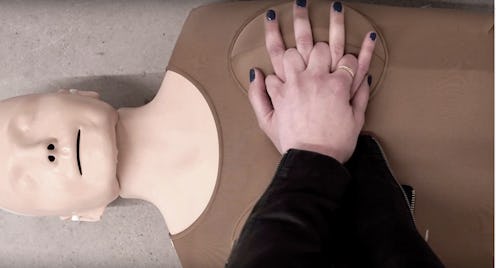It's well established that cardiopulmonary resuscitation, or CPR, can save someone's life during cardiac arrest. But plenty of research has shown that women are not only less likely to recognize the symptoms of a heart attack, but are less likely to receive CPR from people around them. One reason researchers cite? Bystanders are afraid of touching women's breasts while administering the lifesaving procedure. Really. Now, a new training tool, the Womanikin, wants to make people more comfortable giving CPR to people with breasts.
"Regardless of someone’s gender or how their body is shaped, delivering bystander CPR during cardiac arrest is absolutely critical, as it has been proven to double and even triple a victim’s chance of survival," lead study author, Audrey Blewer, MPH, assistant director for Educational Programs at the Center for Resuscitation Science at Penn Medicine, said in a press release about a study looking at these CPR disparities.
As most things are developed with men in mind, it's not surprising that people are trained in CPR using dummies that resemble men's bodies. New York-based creative agency JOAN allows trainees to simulate performing CPR on women. What's more, CPR trainers can download the WoManikin designs for free to make their own attachment.
The design was created with the "collaboration of CPR experts, cardiologists, creatives, organizations, and people who care about keeping women alive." Womanikin aims to get the attachment into every CPR training school by the end of 2020, according to its website. This in turn could empower more people to assist women having cardiac episodes in public.
While performing CPR while using the correct hand positioning does require touching a person's left breast, that touch could save a women's life. I was trained in CPR as a lifeguard in college, and it never occurred to me not to perform CPR on a woman because I might touch her breasts. (Perhaps this is because I myself am a woman.)
The research from Penn suggests that some people are indeed uncomfortable, likely because they only received training on a male body prototype (though some trainings include infant CPR as well), and that training people on different body types can increase the chances women will receive CPR in emergencies. This is why it's vital to get more people trained in CPR that directly addresses people with different body types.
According to the Penn study, men are 23% more likely to survive cardiac arrest without CPR than women. Coupled with the fact that women are less likely to receive CPR in public and are more likely survive if they do receive it, women are at a significantly higher risk of dying from a cardiac episode because people are apprehensive about offering assistance.
"By uncovering this disparity, we’ll be able to think about new ways to train and educate the public on when, why, and how to administer bystander CPR, in order to help save more lives — of both men and women," Blewer said.
If you're not trained in CPR, it's a good skill to have. You can get certified in CPR, first aid, and rescue breathing at your local Red Cross. While I've never had to administer CPR, bring trained in both CPR and emergency first aid has empowered me to feel confident enough to help strangers in an emergency. And I have assisted people who have had public medical episodes by providing basic first aid and calling for help. The more you know, and the more prepared you are, the more likely you are to automatically spring into action. And by doing so, you just might save a life.
